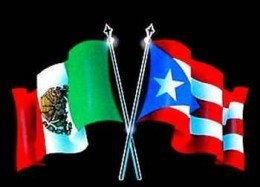
CLEVELAND FEATURED STORIES
This free script provided by
JavaScript
Kit
Current world population (estimated): .
This free script provided by
JavaScript Kit
By: Bernardo Lozano
El Tango Latin Mexican Grill, located on busy Madison Avenue in Lakewood will pleasantly surprise you.........Read me
................................................................................................................................
................................................................................................................................

Senoritas Bonitas Restaurant
Beautifully decorated with pretty girls on the wall staying true to its name, Senorita Bonita's has been in the city of Solon at the Enterprise....Read More
"LEAVE NO VET BEHIND"
By: Randy Caraballo-Rosa
The show got started with Angel Figueroa, who was making his pro debut. Figueroa pulled out the victory by.......Read More

Mexicans and Puerto Ricans: They Are Not the Same.

Differences & Resemblances: How to Tell Them Apart
Being a Puerto Rican myself, I have had my fair share of mistaken ethnic identity by curious inquirerers. I can see why they would be confused. Mexicans and Puerto Ricans make up the two largest Spanish-speaking groups in the United States. However, we have more in common than not.
Mexican & Puerto Rican Ethnic Origins
Both ethnic groups have their origins from Spain a result of Christopher Columbus' comissioned discovery of the New World. Spanish Conquistadores gained control of both formerly-called Borikén and México-Tenochtitlan, which are presently known as Puerto Rico and Mexico.
Puerto Rico's ethnic history is curiously a miniature scale of that of the United States mainland's, but not entirely. Europeans brought along African slaves to supplement the almost-extinct Taino Indian population. Their main goal was to excavate and take the island's gold back to Europe, which can be currently found in its lavish cathedrals.
Eventual inter-marriages among the indigenous Tainos, Europeans and African slaves led to the very varied mixture of races that is commonly found on the island as well as in the United States. Therefore, there is no typical Puerto Rican per se. The people can range from blonde-haired, blue-eyed to mid-range colored skin, or to actual Black in color.
Contrary to Puerto Rico, Mexico did not participate in the importation of African slaves into their ancestral origins. They did, however, have a group of indigenous people called the Aztec Indians, which intermingled with the European races. The majority of Mexicans have strong indigenous physical features such as straight hair, brown skin, and Asiatic eye shapes.
Immigration & Politics
Puerto Ricans are United States citizens by birth after being previously naturalized by the Jones-Shafroth Act of 1917. The island of Puerto Rico is a Commonwealth of the United States just as Autralia is a Commonthwealth of England. Therefore, Puerto Ricans are free to move to the mainland from the island and vice-versa without a passport.
On the other hand, many Mexicans have had to illegally cross the United States-Mexico border in order to migrate to the United States. The Unites States government has currently been facing criticism in their economic relations by anti-globalists citing that the government does not combat illegal immigration effectively.
Heritage & Cultural Features
Even though both groups are connected by the Spanish language, there are variations in accents and vocabulary. This stemmed from the indigenous influence from each of the groups' native ancestries.
Puerto Ricans pride themselves in their musical heritage. Genres of salsa , merengue and reggaeton are central and prominent in social get-togethers. In sports, baseball is Puerto Rico's main sport with Mexico's being soccer, or f útbol .
Mexican's pride is strongly rooted in the mariachi and banda music genres. Both nationalities have produced artists of international reknown that have created unity between the two with mutual fans. Carlos Santana and Jennifer Lopez are just examples of the many successful representatives of each group.
Each's ethnic cuisines are very different with the exception of rice and beans being common items on both Mexican and Puerto Rican menus.
Animosity Between the Two
For many years now, there have been feuds between Mexicans and Puerto Ricans. Much of it stems from a sense of right and entitlement that each group acclaims. There are resentments due to illegal immigration, crimes, gangs and collective prejudice from non-Latinos that assume both ethnicities are the same.
When President Obama appointed Sonia Sotomayor, of Puerto Rican descent, for the United States Supreme Court, many Mexican-Americans were in an uproar as they felt it should have been one of their own so as to better understand the immigration issues of the country.
By jcm_blabs
www.Vocerolatinonews.com
















